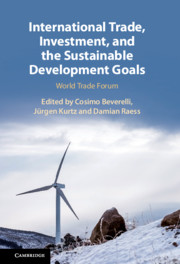Book contents
- International Trade, Investment, and the Sustainable Development Goals
- International Trade, Investment, and the Sustainable Development Goals
- Copyright page
- Contents
- Figures
- Tables
- Contributors
- Preface
- Introduction
- Part I Penetration and Diffusion of the Sustainable Development Goals
- Part II Top-Down: Public Approaches to Achieving the Sustainable Development Goals
- 4 The Trade Effects of Environmental Provisions in Preferential Trade Agreements
- 5 Facilitating Sustainable Investment
- Part III Bottom-Up: Private Sector and Civil Society Initiatives on the Sustainable Development Goals
- Index
- References
5 - Facilitating Sustainable Investment
The Role and Limits of Investment Promotion Agencies
from Part II - Top-Down: Public Approaches to Achieving the Sustainable Development Goals
Published online by Cambridge University Press: 18 September 2020
- International Trade, Investment, and the Sustainable Development Goals
- International Trade, Investment, and the Sustainable Development Goals
- Copyright page
- Contents
- Figures
- Tables
- Contributors
- Preface
- Introduction
- Part I Penetration and Diffusion of the Sustainable Development Goals
- Part II Top-Down: Public Approaches to Achieving the Sustainable Development Goals
- 4 The Trade Effects of Environmental Provisions in Preferential Trade Agreements
- 5 Facilitating Sustainable Investment
- Part III Bottom-Up: Private Sector and Civil Society Initiatives on the Sustainable Development Goals
- Index
- References
Summary
Today almost every country in the world has an investment promotion agency (IPA) to attract and retain foreign investment. In principle, IPAs could be an important tool in advancing the sustainable development agenda, as they provide a country-led, domestically legitimate means of catalyzing new foreign investments. We argue that IPAs’ governance structures condition their potential contribution to sustainable development, by leading them to privilege certain ideas and interests over others. Specifically, IPAs that are more autonomous from the government bureaucracy tend to prioritise activities to increase overall inflows of foreign investment, while IPAs that are more integrated into the government bureaucracy are more likely to structure their activities in ways that prioritise their countries’ industrial policy goals. Evidence from World Bank surveys of IPA officials and a case study of Costa Rica’s IPA demonstrate how agencies’ governance structures incentivise them to approach their mandates in different ways, which in turn influences their contribution to sustainable, inclusive development. This research enriches our understanding of investment promotion as a tool for sustainable development and contributes to ongoing debates on how states manage economic globalisation.
Keywords
- Type
- Chapter
- Information
- International Trade, Investment, and the Sustainable Development GoalsWorld Trade Forum, pp. 140 - 174Publisher: Cambridge University PressPrint publication year: 2020
References
- 6
- Cited by



